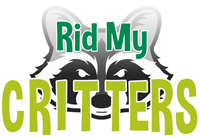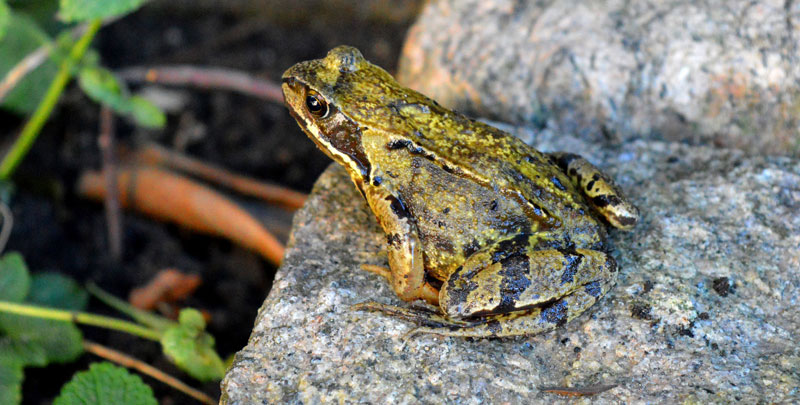Frogs are a popular addition to aquariums and are often welcome as garden protectors, but are they really safe to have around?
There are many species out there that release dangerous toxins when threatened.
So how do you know if you’re dealing with poisonous frog species or safe ones, and what other potential problems could they cause?
Let’s take a deeper look at life with these hoppy critters.
Local Frogs 101
One thing we should make clear immediately is that most New World poisonous frogs are located in Central and South America.
As there are exceptions, knowing what species are likely to visit you is important.
Common Species Found Near US Homes
Frogs can be found in every state, even Hawai’i and Alaska. Thankfully, almost all of them are non-toxic.
For example, the American green tree frog (Dryophytes cinereus) can often be found visiting gardens and ponds throughout the south and eastern states.
The eastern gray treefrog (Dryophytes versicolor) can be found throughout the eastern US and southeastern Canada.
Toads, which are just a nickname for frogs with dry, bumpy skin, often prefer drier, more terrestrial habitats than smooth-skinned frogs.
You’re more likely to get frogs on your property if you have water features or are near wetlands or a body of water.
Because toads can tolerate drier climates than most frogs, homes further from moisture may still get visits from a toad.
Poisonous Species in the US
You might have heard of the erroneously-named poison dart frogs or the deadly golden poison frog.
Thankfully, these aren’t native to the US and you’ll probably never meet one outside of a zoo. In fact, there are only three species native to the US, but only the Pickerel frog tends to get credit.
Perhaps this is because the average person considers frogs and toads to be different animals, despite all toads being frogs. These three species are:
Fowler’s Toad (Anaxyrus fowleri)
These big guys can be found throughout the central and eastern states, as well as parts of Canada. They can grow to an impressive 3.7 inches long and prefer forests and wetlands.
Oak Toad (Anaxyrus quercicus)
Much like Fowler’s toad, this species is native but doesn’t get any credit. It can be found all along the East Coast and is the tiniest North American frog at only 1.3 inches long.
Pickerel frog (Lithobates palustris)
Found throughout most of the East Coast and sporadically throughout the Midwest, the species can be identified by up to 21 rectangular spots on its back in two columns.
There’s also a yellow pattern on the inside of its hind legs, but it’s not a good idea to pick one up to look without proper protection. Females tend to be darker and larger than males.
As with most species, the Pickerel mixes a toxin into its skin secretions to deter predators. These toxic chemicals are mildly irritating to healthy adults but could be dangerous to pets.
Non-Native Poisonous Species
There are a few toxic species that aren’t native to the US which you might encounter.
In most cases, these species excrete bufotoxin, a chemical that is only mildly irritating to healthy adults but can kill dogs and small pets.
Cane Toad (Rhinella marina)
This species can easily kill a dog and was introduced in many locations to help control cane beetles and similar pests. Thankfully, you won’t spot one in the US unless you’re visiting the Caribbean territories or the Florida Keys.
Colorado River toad (Incilius alvarius)
Native to Mexico and found along the lower parts of the Colorado River, this species can get you arrested. This is because a chemical in its secretions is considered a Schedule 1 controlled substance.
More importantly, it is listed as threatened status in both New Mexico and California, making it illegal to capture one there.
If you see one of these critters in your yard, make sure to call your local wildlife agency to ensure safe and legal removal!
Eastern American Toad (Anaxyrus americanus americanus)
Found throughout the eastern US, this subspecies isn’t actually native to the US. Instead, American toads are believed to have migrated from South America on natural vegetation “rafts”.
There are also two other subspecies that can be found in the US and Canada within the Eastern American Toad’s range.
Green-and-Black Poison Dart Frog (Dendrobates auratus)
This beautiful species was introduced to Hawai’i from Costa Rica to help fight mosquitos.
If encountered in the wild, their secretions are dangerous enough to stop a human heart. However, when kept as pets, they lose their toxicity.
Western Toad (Anaxyrus boreas)
Native to Western Canada, this species can be found all among the western seaboard and have migrated as far east as Montana and Wyoming.
There are two subspecies, the Boreal toad and California toad.
Are Brown Frogs Poisonous or Just Brightly Colored Ones?
Contrary to popular believe, bright colors aren’t always the best way to identify poisonous frogs. In fact, most of the toxic toads we’ve mentioned are brown or gray in color.
When you spot a hopper you don’t recognize in your yard or garden, be sure to get a good picture and treat it as toxic until you can confirm its identity.
Benefits of Having Frogs Around
There are several advantages to having frogs around your home, as they’re a valuable part of the ecosystem. Let’s look at three great reasons to keep these little guys around.
#1 – Pest Control
One of the main reasons you’d want to have frogs in your garden is for their innate ability to control pests.
Frogs, and especially toads, are known to be natural predators and can eat a substantial amount of insects. Even baby frogs can eat a lot of bugs, such as mosquito larvae.
Once fully grown, a single frog can eat over 100 insects a day, including caterpillars, sow bugs, and cutworms, which are potentially harmful to your plants.
With frogs patrolling your garden, you significantly reduce, or even eliminate, the need for harmful pesticides. Best of all, some larger species will even eat spiders and small rodents.
This not only helps maintain a balanced ecosystem but also contributes to the health of your garden and local environment.
#2 – Indicator Species
Frogs are often considered indicator species because they are incredibly sensitive to changes in their surroundings.
Their permeable skin makes them vulnerable to toxins and pollution. This means the presence of healthy frogs signifies a clean and healthy environment.
If you see frogs thriving around your home, it’s a sign that your local ecosystem is in good condition. Additionally, monitoring the frog populations in your area can help scientists detect potential environmental issues early on.
This makes frogs valuable for both your immediate environment and for the broader understanding of ecological health.
#3 – Pets
Frogs are a great companion for aquariums. Not only do they help keep an aquarium clean and pest-free, they’re relaxing to watch.
In your garden, they can help protect the fish in water features from insect pests and parasites.
Potential Risks and Concerns
While frogs can be beneficial to your garden, there are some potential risks and concerns associated with having them around your home (and especially inside your home).
Again, let’s look at three major concerns with having frogs hanging about. We won’t go over finding a frog in your toilet but that has been known to happen.
#1 – Toxin Exposure
While uncommon, there are poisonous frogs in the US, as we’ve discussed earlier. Their toxins can cause irritation or other adverse effects to people and pets upon contact.
To minimize the risk of toxin exposure, try to identify any frog you encounter before handling. You should handle even non-toxic frogs with care, as they have very fragile skin.
Teach your children and pets to avoid contact with all wild frogs to avoid toxins or potential contamination.
If you or your pets come into contact with a toxic frog, wash the affected area thoroughly with soap and water. If a more severe reaction occurs, seek medical attention immediately.
#2 – Noise Pollution
Frogs and toads are known for their vocalizations, especially during the mating season.
Although you may find their calls interesting at first, they can become a source of noise pollution if they decide to form a midnight choir. The constant noise could make it difficult for you and your family to sleep or enjoy your outdoor space.
To reduce noise pollution from frogs, you can try several methods such as adjusting your outdoor lighting to make your yard less attractive to them. You can also remove potential breeding sites like standing water (including an unused pool) sources or deter them from your garden.
By taking these steps, you can create a more comfortable living environment for yourself and your neighbors without harming the frogs.
#3 – Unwanted Predators
Just as frogs eat bugs, many other critters eat frogs. These little guys can attract some larger spiders, lizards, garter snakes, and predatory birds.
They also don’t discriminate when they feed, meaning beneficial bugs can also be eaten.
Safe Coexistence With Frogs
So now that you know the pros and cons, how do you invite frogs without the risks?
This is a little more complicated since you don’t want too many at once. Here are the two best ways to cohabitate safely
Creating a Frog-Friendly Habitat
A frog-friendly space requires shelter, food, and water sources to support their needs. Adding a small pond or water feature in your garden can be a great way for frogs to access water for breeding and hydration.
Incorporate native plants, rocks, and logs around the pond to create hiding spots and refuge areas for frogs during the day. This kind of environment not only benefits frogs but also attracts other beneficial insects such as pollinators.
Depending on the type of frog, choose appropriate landscaping. For example, trees and shrubs shelter tree species, while frog mud mounds protect burrowing species.
When choosing what to use to keep frogs away from sensitive areas such as the pool or house, aim for non-lethal options. Also, make the spaces near these locations less hospitable so the hoppers will stick to spaces you’ve chosen.
Limiting Hazards
It’s essential to limit potential hazards to maintain a safe coexistence with frogs around your home.
Be cautious about using pesticides, as they can harm or even kill frogs quickly. Opt for natural pest control methods like inviting beneficial insects or using companion planting to deter pests.
Keeping your pets under control, especially at night when frogs are active, can also help protect these critters.
Ensure your pets or local scavengers don’t have easy access to frog habitat areas. Consider providing escape routes for frogs, such as small passages through fences or barriers.
Remember that some frogs can be harmful to native species due to predation and competition for resources. There’s also the risk that poison frog species might want to move in.
In such cases, you’ll need to take additional steps to manage their presence for the benefit of native frogs and local ecosystems.
Final Note
So are frogs dangerous or beneficial for your property?
The answer really comes down to what you need, whether you manage the population, and the steps you take regarding frog predators. The risk of a poisonous frog is low, but should always be taken into consideration.
By inviting non-toxic frogs to your garden while deterring them from buildings, these little bug gobblers can be a great natural protector for your property.
- How to Identify Skunk Poop (With Pictures) - April 1, 2024
- You Really Don’t Need That Opossum Trap - January 4, 2024
- How to Set a Mouse Trap Without Getting Hurt - December 28, 2023

